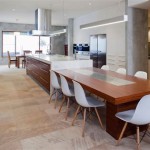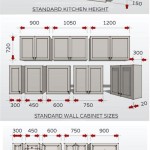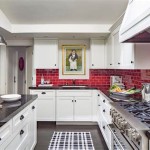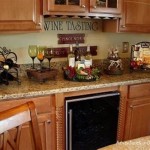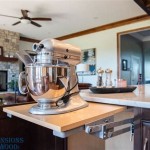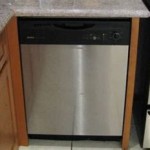Designing the Ultimate Outdoor Oasis: Integrating Kitchens and Hot Tubs
The integration of an outdoor kitchen and a hot tub transforms a simple backyard into a versatile and luxurious living space. This combination allows homeowners to extend their entertaining options, enjoy meals al fresco, and unwind in a relaxing spa environment, all within the comfort of their own property. Planning such a project requires careful consideration of various factors, including space, budget, climate, and personal preferences. A well-designed outdoor kitchen and hot tub area can significantly enhance property value and provide years of enjoyment.
Before embarking on the project, it’s crucial to assess the available space. Consider the dimensions of the yard, the existing landscaping, and any potential obstructions such as trees, fences, or utility lines. The layout should optimize functionality and flow, ensuring easy access between the kitchen, the hot tub, and any other outdoor living areas. A scale drawing or a 3D rendering can be invaluable in visualizing the final result and identifying any potential design flaws early on. This planning phase can also involve consultation with landscape architects or contractors who specialize in outdoor living spaces.
Budget is another critical factor. Outdoor kitchens can range from simple barbecue setups to elaborate installations with built-in grills, refrigerators, and countertops. Hot tubs also vary widely in price, depending on size, features, and materials. It’s important to establish a realistic budget and to prioritize features accordingly. Consider the long-term costs of maintenance and operation, such as electricity, water, and propane. Obtaining multiple quotes from different contractors can help to ensure competitive pricing.
Key Considerations for Outdoor Kitchen Design
Designing an outdoor kitchen involves careful consideration of several key elements. Functionality, durability, and aesthetics should all be balanced to create a space that is both practical and visually appealing. The choice of materials is crucial, as they must be able to withstand the elements and require minimal maintenance. In addition, the layout should optimize workflow and allow for easy movement within the cooking area.
The central element of any outdoor kitchen is the grill. Choosing the right grill depends on cooking style, budget, and space constraints. Options range from traditional charcoal grills to high-end gas grills with multiple burners and advanced features. Built-in grills offer a seamless and integrated look, while freestanding grills provide greater flexibility and portability. Consider the size of the grilling surface and the availability of features such as side burners, rotisseries, and smokers.
Countertop space is essential for food preparation and serving. Durable and weather-resistant materials such as granite, concrete, and stainless steel are popular choices. The countertop should be large enough to accommodate cutting boards, utensils, and serving dishes. Consider incorporating a bar area with seating for guests. This can create a more social and interactive cooking experience. Adequate lighting is also crucial for safety and functionality, especially during evening hours. Consider incorporating task lighting over the cooking area and ambient lighting to create a more inviting atmosphere.
Storage is another important consideration. Outdoor kitchens often require storage for grilling tools, cookware, and other supplies. Built-in cabinets and drawers made from weather-resistant materials such as stainless steel or marine-grade polymer are ideal. Consider incorporating a trash receptacle and a recycling bin to keep the area clean and organized. In addition, a refrigerator or beverage center can be a valuable addition, allowing for convenient access to cold drinks and perishable ingredients.
Ventilation is crucial for outdoor kitchens, particularly if they are located under a covered patio or pergola. A range hood or exhaust fan can help to remove smoke and odors, improving air quality and preventing the build-up of grease and grime. Consider the prevailing wind direction when planning the layout of the kitchen to minimize the impact of smoke on guests and nearby structures.
Integrating a Hot Tub into the Outdoor Space
Integrating a hot tub into the outdoor space requires careful planning to ensure safety, privacy, and accessibility. Consider the hot tub's dimensions, the surrounding landscaping, and any potential obstructions. The layout should optimize the flow between the hot tub and other outdoor living areas, such as the kitchen, patio, or deck. A well-designed hot tub area can provide a relaxing and enjoyable experience, enhancing the overall appeal of the outdoor space.
Choosing the right hot tub is essential. Factors to consider include size, features, and construction materials. Hot tubs come in a variety of sizes, ranging from small two-person models to large spas that can accommodate six or more people. Consider the number of people who will be using the hot tub regularly and choose a size that is appropriate. Features such as jets, lighting, and sound systems can enhance the hot tub experience. Construction materials such as acrylic, fiberglass, and wood should be durable and weather-resistant.
Privacy is another important consideration. If the hot tub is located in a visible area, consider adding privacy screens, fencing, or landscaping. Plants such as bamboo, evergreens, and shrubs can provide natural screening and create a more secluded atmosphere. A pergola or gazebo can also provide privacy and protection from the elements. Consider the local building codes and regulations regarding hot tub enclosures.
Safety is paramount. Ensure that the hot tub area is properly illuminated to prevent accidents. Install non-slip surfaces around the hot tub to reduce the risk of falls. Consider adding handrails or steps to make it easier to enter and exit the hot tub. Keep the hot tub covered when it is not in use to prevent debris from entering and to conserve energy. Regularly test and maintain the water to ensure that it is safe and sanitary.
Accessibility is also important. Ensure that the hot tub is easily accessible from the house and other outdoor living areas. A pathway or walkway leading to the hot tub should be well-lit and free of obstacles. Consider adding a changing area or shower nearby for convenience. If the hot tub is located on a raised deck or patio, ensure that the structure is strong enough to support the weight of the hot tub and the water.
Creating a Seamless Design and Flow
Creating a seamless design and flow between the outdoor kitchen and the hot tub area is essential for creating a cohesive and functional outdoor living space. Consider the overall aesthetic of the backyard and choose materials and finishes that complement each other. Pay attention to the layout and ensure that there is a clear and logical flow between the different areas. Integrate landscaping and lighting to create a welcoming and inviting atmosphere.
Choose a consistent design theme. Whether it's rustic, modern, or traditional, a consistent design theme will help to tie the different elements of the outdoor space together. Use similar materials, colors, and textures throughout the kitchen and hot tub area. This creates a sense of visual harmony and makes the space feel more cohesive. Consider incorporating elements such as stone, wood, or metal to add character and visual interest.
Pay attention to the layout. The layout should optimize the flow between the different areas of the outdoor space. The kitchen should be conveniently located near the dining area and the hot tub. Ensure that there is ample space for circulation and that the pathways are wide enough to accommodate multiple people. Consider the prevailing wind direction when planning the layout to minimize the impact of smoke and odors on guests.
Integrate landscaping. Landscaping can play a crucial role in creating a seamless design and flow between the outdoor kitchen and the hot tub area. Use plants to define spaces, create privacy, and add visual interest. Consider incorporating a variety of textures, colors, and heights to create a dynamic and engaging landscape. Choose plants that are well-suited to the local climate and that require minimal maintenance.
Incorporate lighting. Lighting is essential for creating a welcoming and inviting atmosphere in the outdoor space. Use a combination of task lighting, ambient lighting, and accent lighting to create a layered effect. Task lighting should be focused on the cooking and preparation areas in the kitchen, while ambient lighting can be used to illuminate pathways and create a general sense of warmth. Accent lighting can be used to highlight specific features such as plants, sculptures, or architectural details.
Furniture selection also plays a pivotal role in the seamlessness of the overall design. Choose outdoor furniture that is comfortable, durable, and stylish. Consider the size and scale of the furniture in relation to the space. Use outdoor rugs and cushions to add color and texture. Incorporate elements such as outdoor umbrellas and patio heaters to extend the usability of the space throughout the year.
Ultimately, the goal is to create an outdoor living space that is both functional and aesthetically pleasing. By carefully considering the design elements and paying attention to the details, homeowners can create an outdoor oasis that they can enjoy for years to come. A well-designed outdoor kitchen and hot tub area can enhance property value, improve quality of life, and provide a perfect setting for entertaining and relaxation. The key is to plan meticulously, choose high-quality materials, and execute the design with precision. The resulting backyard transformation will undoubtedly be a worthwhile investment.

Outdoor Kitchens Pergolas Traditional Swimming Pool Hot Tub Dallas By Pulliam Pools Houzz

Screened Area With Sunken Spa Fire Pit And Outdoor Kitchen Tropical Patio Jacksonville By Creative Design Space Inc Houzz

Pin Page

Stone Patio With Outdoor Kitchen Hot Tub And Koi Pond Hidden Creek Landscaping Hgtv

Stone Patio With Outdoor Kitchen Hot Tub And Koi Pond Hidden Creek Landscaping Hgtv

11 Smart Backyard Hot Tub Ideas Amber Freda Landscape Design

Screened Area With Sunken Spa Fire Pit And Outdoor Kitchen Tropical Patio Jacksonville By Creative Design Space Inc Houzz

Covered Outdoor Kitchen 15 Stunning Ideas How To Choose Rta Living

Incredible Deck With Built In Hot Tub Full Backyard Makeover Time Lapse Youtube

20 Garden Kitchen Ideas For The Perfect Outdoor Cooking Area


